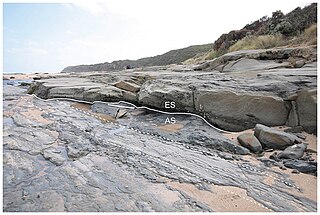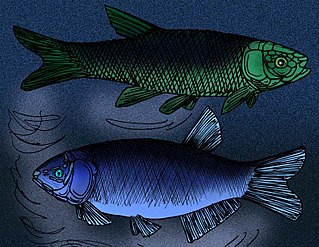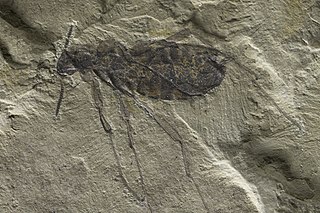
Ephedraceae is a family of gymnosperms belonging to Gnetophyta, it contains only a single extant genus, Ephedra, as well as a number of extinct genera from the Early Cretaceous.

Gnetophyta is a division of plants, grouped within the gymnosperms, that consists of some 70 species across the three relict genera: Gnetum, Welwitschia, and Ephedra. The earliest unambiguous records of the group date to the Jurassic, and they achieved their highest diversity during the Early Cretaceous. The primary difference between gnetophytes and other gymnosperms is the presence of vessel elements, a system of small tubes (xylem) that transport water within the plant, similar to those found in flowering plants. Because of this, gnetophytes were once thought to be the closest gymnosperm relatives to flowering plants, but more recent molecular studies have brought this hypothesis into question, with many recent phylogenies finding them to be nested within the conifers.

Horseshoe crabs are marine and brackish water arthropods of the family Limulidae and the only living members of the order Xiphosura. Despite their name, they are not true crabs or crustaceans: they are chelicerates, most closely related to arachnids such as spiders, ticks, and scorpions.

Xiphosura is an order of arthropods related to arachnids. They are more commonly known as horseshoe crabs. They first appeared in the Hirnantian. Currently, there are only four living species. Xiphosura contains one suborder, Xiphosurida, and several stem-genera.
The Mazon Creek fossil beds are a conservation lagerstätte found near Morris, in Grundy County, Illinois. The fossils are preserved in ironstone concretions, formed approximately 309 million years ago in the mid-Pennsylvanian epoch of the Carboniferous period. These concretions frequently preserve both hard and soft tissues of animal and plant materials, as well as many soft-bodied organisms that do not normally fossilize. The quality, quantity and diversity of fossils in the area, known since the mid-nineteenth century, make the Mazon Creek lagerstätte important to paleontologists attempting to reconstruct the paleoecology of the sites. The locality was declared a National Historic Landmark in 1997.

The Eumeralla Formation is a geological formation in Victoria, Australia whose strata date back to the Early Cretaceous. It is Aptian to Albian in age. Dinosaur remains are among the fossils that have been recovered from the formation, particularly from the Dinosaur Cove locality.

Wadeichthys oxyops is an extinct archaeomaenid bony fish from the Koonwarra Lake fauna of Lower Cretaceous Victoria, Australia. If the related genus Koonwarria is regarded as being in a different family, then W. oxyops is the only known Cretaceous-aged archaeomaenid.

Koonwarria manifrons is an extinct genus of ray-finned fish that lived in a polar lake in what is now Koonwarra, Victoria, Australia during the Early Cretaceous epoch. Fossils have been retrieved from the Strzelecki Group.
The Wallumbilla Formation is an Aptian geologic formation found in Australia. Plesiosaur and theropod remains are among the fossils that have been recovered from its strata.
Atherimorpha is a genus of snipe fly of the family Rhagionidae.
Koonwarra is a town in the South Gippsland region of Victoria, Australia. At the 2016 census, Koonwarra had a population of 404. The town straddles the South Gippsland Highway. Located around 128 km southeast of Melbourne, the town was served by rail from the 1890s until 1991 with the closing of the rail line to Barry Beach.
Palaeoechinastacus australianus is a species of freshwater crayfish known from Early Cretaceous fossils from Victoria, Australia.

Austrolimulidae is an extinct family of horseshoe crabs belonging to the infraorder Limulina. Members of the family are known from the Permian to the beginning of the Jurassic, though one species has been reported from the end of the Cretaceous. Austrolimulids are known for amongst the most extreme morphologies among Xiphosurids, including large elongated genal spines. Unlike living Limulids, Austrolimulids were likely adapted for freshwater and brackish environments. They are considered to be the sister group to Limulidae, the group that contains all modern horseshoe crabs.

Archaeomaenidae is an extinct family of stem-teleost fish found in freshwater environments of Jurassic New South Wales of Australia, China, and Antarctica, and in Lower Cretaceous New South Wales and Mongolia.
Praeaulacidae is an extinct family of Mesozoic parasitic wasps in the suborder Evanioidea. It among the earliest known families of the group and is characterised by more complete wing venation in comparison to other members of the suborder. It has been found that Othniodellithidae is nested within Praeaulacidae via cladistic analysis.
Lophioneurida is an extinct order of Thysanoptera, dating from the Carboniferous to the Cretaceous. It is likely paraphyletic, with modern thrips having evolved from members of the group.

Tarwinia is an extinct genus of stem-group flea known from a single species, T. australis, from the Early Cretaceous (Aptian) Koonwarra Fossil Bed of Victoria, Australia, it is the only member of the family Tarwiniidae, and the only stem-group flea known from the Southern Hemisphere.

Orthophlebiidae is an extinct family of scorpionflies known from the Triassic to Cretaceous, belonging to the superfamily Panorpoidea. The family is poorly defined and is probably paraphyletic, representing many primitive members of Panorpoidea with most species only known from isolated wings, and has such been considered a wastebasket taxon.

Coccolepididae is an extinct family of ray-finned fish, known from the Early Jurassic to Early Cretaceous, most of which were originally referred to the type genus Coccolepis. They had a widespread distribution, being found in North and South America, Australia, Asia and Europe. They are mostly known from freshwater environments, though several species have been found in marine environments. They are morphologically conservative, and have poorly ossified endo and exoskeletons, which usually results in poor preservation. This makes it difficult to distinguish species. They are generally small fish, with the largest known specimens reaching a length of 210 mm. Historically, they have been classified as members of “Palaeonisciformes”, a paraphyletic grouping of non-neopterygian fish, due to their plesiomorphic conservative morphology closely resembling those of many other groups of primitive fish. They have been suggested to be relatives of the Acipenseriformes within the Chondrostei.
Michael Waldman is a British palaeontologist known for his work on fossil fish, mammals, and reptiles. He also discovered the globally important fossil site of Cladach a'Ghlinne, near Elgol on the Isle of Skye, Scotland. This site exposes the Kilmaluag Formation and provides a valuable record of Middle Jurassic ecosystems. During the 1970s he visited the site several times with fellow palaeontologist Robert Savage. The fossil turtle Eileanchelys waldmani was named after Michael in recognition of his notable contribution to palaeontology.












